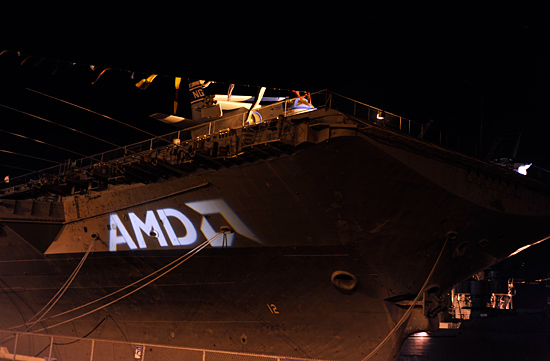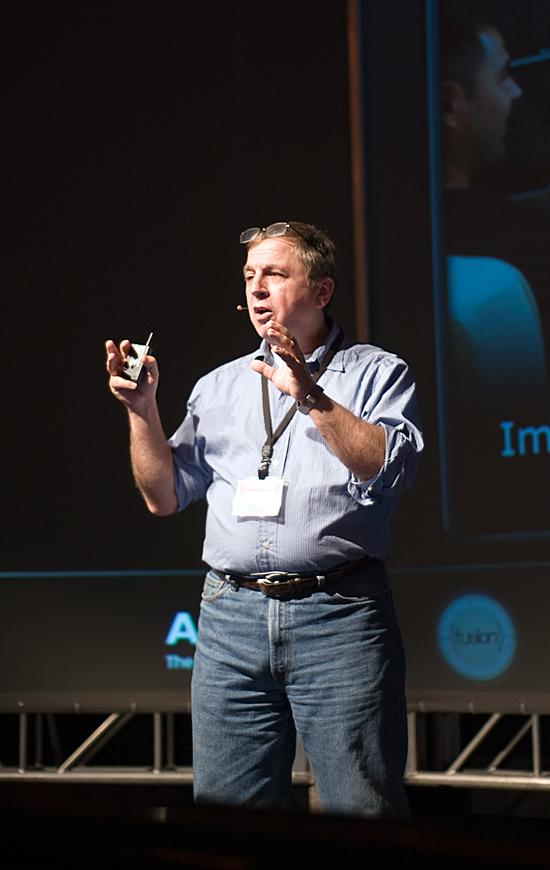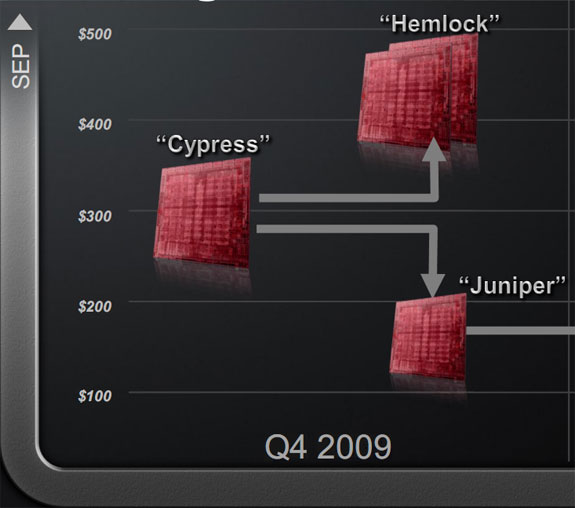The RV870 Story: AMD Showing up to the Fight
by Anand Lal Shimpi on February 14, 2010 12:00 AM EST- Posted in
- GPUs
The Call
My love/hate relationship with AMD PR continued last year. But lately, it’s been far less hate. Let’s rewind back to the Summer of 2009. I’d been waiting for AMD to call for weeks.
We all knew that the RV870 was going to launch sometime before the end of the year, and we’re normally briefed on new GPUs around a month or so before we get hardware. The rumors said that the launch had been pushed back, but just like clockwork I got a call in June or July of last year. It was my old friend, Chris Hook of AMD PR.

This time he wanted me to come to a press event on a carrier off the coast of California. Sigh.
It’s not that I have anything against carriers. It’s just that all I cared about at that time was the long awaited successor to the RV770. The RV770 was the GPU that unequivocally restored my faith in ATI graphics, an impact shared by others last June. But that’s not how the game is played I’m afraid. AMD promises its management and its partners that they can fill a room (or carrier) up with important press. We get promised access to engineers, useful information and free drinks.

The USS Hornet. GPUs are in there.
I’m not easily swayed by free drinks, but Chris Hook knows me well enough by now to know what I’d appreciate even more.
The Dinner - September 2009
I had to leave dinner earlier than I wanted to. ASUS’ Chairman Jonney Shih was in town and only had one opportunity to meet me before I left Oakland. Whenever either of us happens to be in the same town, we always make our best effort to meet - and I wasn’t going to let him down. In the same vein that Steve Jobs is successful because he is a product guy at heart, running a company best known for its products. Jonney Shih is an engineer at heart, and he runs a company who has always been known for their excellence in engineering. This wasn’t just another meeting with an executive, this was a meeting with someone who has a passion for the same things I do. His focus isn’t on making money, it’s on engineering. It’s a rare treat.
My ride was waiting outside. I closed the lid on my laptop, making sure to save the 13 pages of notes I just took while at dinner. And I shook this man’s hand:

Before I left he asked me to do one thing. He said “Try not to make the story about me. There are tons of hardworking engineers that really made this chip happen”. Like Jonney, Carrell Killebrew has his own combination of traits that make him completely unique in this industry. All of the greats are like that. They’ve all got their own history that brought them to the companies that they work for today, and they have their own sets of personality traits that when combined make them so unique. For Carrell Killebrew it's a mixture of intelligence, pragmatism, passion and humility that's very rare to see. He's also a genuinely good guy. One of his tenets is that you should always expect the best from others. If you expect any less than the best, that’s all you’ll ever get from them. It’s a positive take on people, one that surprisingly enough only burned Carrell once. Perhaps he’s more fortunate than most.
Mr. Killebrew didn’t make the RV870, but he was beyond instrumental in making sure it was a success. What follows is a small portion of the story of the RV870, the GPU behind the Radeon HD 5800 series. I call it a small portion of the story because despite this article using more than eight thousand words to tell it, the actual story took place over years and in the minds and work of hundreds of engineers. This GPU, like all others (even Fermi) is the lifework of some of the best engineers in the industry. They are the heroes of our industry, and I hope I can do their story justice.
As is usually the case with these GPU backstories, to understand why things unfolded the way they did we have to look back a few years. Introducing a brand new GPU can take 2 - 4 years from start to finish. Thus to understand the origins of the Radeon HD 5800 series (RV870) we have to look back to 2005.
Sidebar on Naming
AMD PR really doesn’t like it when I use the name RV870. With this last generation of GPUs, AMD wanted to move away from its traditional naming. According to AMD, there is no GPU called the RV870, despite the fact that Carrell Killebrew, Eric Demers and numerous others referred to it as such over the past couple of years. As with most drastic changes, it usually takes a while for these things to sink in. I’ve also heard reference to an RV870 jar - think of it as a swear jar but for each time someone calls Cypress an RV870.

Why the change? Well, giving each member of a GPU family a name helps confuse the competition. It’s easy to know that RV870 is the successor to the RV770. It’s harder to tell exactly what a Cypress is.
AMD PR would rather me refer to RV870 and the subject of today’s story as Cypress. The chart below shows AMD’s full listing of codenames for the 40nm DX11 GPU lineup:
| GPU | Codename |
| ATI Radeon HD 5900 Series | Hemlock |
| ATI Radeon HD 5800 Series | Cypress |
| ATI Radeon HD 5700 Series | Juniper |
| ATI Radeon HD 5600/5500 Series | Redwood |
| ATI Radeon HD 5400 Series | Cedar |
Given that we still haven’t purged the RVxxx naming from our vocabulary, I’m going to stick with RV870 for this story. But for those of you who have embraced the new nomenclature - RV870 = Cypress and at points I will use the two names interchangeably. The entire chip stack is called Evergreen. The replacement stack is called the Northern Islands.










132 Comments
View All Comments
AdiQue - Sunday, February 14, 2010 - link
I fully subscribe to point raised by a few previous posters. Namely, the article being such a worthy read, it actually justifies the creation of an account for the sheer reason of expressing appreciation to your fantastic work, which does stand out in the otherwise well saturated market of technology blogs.geok1ng - Sunday, February 14, 2010 - link
"I almost wonder if AMD’s CPU team could learn from the graphics group's execution. I do hope that along with the ATI acquisition came the open mindedness to learn from one another"it would be a true concern if based on mere observation, but the hard facts are soo much terrible: AMD fired tons of ATI personnel, hence ATI drivers are years behind NVIDIA- we are still begging for centered timings on ATO cards, a feature that NVIDIA offers 6 generations past! ATI produces cards that are gameless. DirectX 10.1?! There was a single game with DirectX 10.1 support, and NVIDIA made the game developer REMOVE DirectX 10.1 features with a game patch that "increased" performance. DirectX 11?! ATI has to put money on driver developing team and spend TONS of cash in game developing.
I would be a happier costumer if the raw performance of my 4870X2 was paired with the seamless driver experience of my previous 8800GT.
And another game that AMD was too late is the netbook and ultralow voltage mobile market. A company with the expertise in integrated graphics and HTPCs GPUs with ZERO market share on this segment?! give me a break!
LordanSS - Monday, February 15, 2010 - link
Funny... after the heaps of problems I had with drivers, stability and whatnot with my old 8800GTS (the original one, 320MB), I decided to switch to ATI with a 4870. Don't regret doing that.My only gripe with my current 5870 is the drivers' and the stupid giant mouse cursor. The Catalyst 9.12 hotfix got rid of it, but it came back on the 10.1.... go figure. Other than that, haven't had problems with it and have been getting great performance.
blackbrrd - Monday, February 15, 2010 - link
I think the reason he had issues with the X2 is that it's a dual card. I think most gfx card driver problems comes from dual cards in any configuration (dual, crossfire, sli)The reason you had issues with the 320mb card is that it had some real issues because of the half-memory. The 320mb cards where cards originally intended as gtx cards, but binned as gts cards that again got binned as 320mb cards instead of 640mb cards. Somehow Nvidia didn't test these cards good enough.
RJohnson - Sunday, February 14, 2010 - link
Please get back under your bridge troll...Warren21 - Sunday, February 14, 2010 - link
Are you kidding me? Become informed before you spread FUD like this. I've been able to choose centered timings in my CCC since I've had my 2900 Pro back in fall 2007. Even today on my CrossFire setup you can still use it.As for your DX10.1 statement, thank NVIDIA for that. You must remember that THEY are the 600lb gorilla of the graphics industry - I fail to see how the exact instance you cite does anything other than prove just that.
As for the DX11 statement, if NVIDIA had it today I bet you'd be singing a different tune. The fact that it's here today is because of Microsoft's schedule which both ATI and NVIDIA follow. NV would have liked nothing more than to have Fermi out in 2009, believe that.
Kjella - Sunday, February 14, 2010 - link
"AMD fired tons of ATI personnel, hence ATI drivers are years behind NVIDIA-"Wow, you got it backwards. The old ATI drivers sucked horribly, they may not be great now either but whatever AMD did or didn't do the drivers have been getting better, not worse.
Scali - Sunday, February 14, 2010 - link
It's a shame that AMD doesn't have its driver department firing on all cylinders like the hardware department is.The 5000-series are still plagued with various annoying bugs, such as the video playback issues you discovered, and the 'gray screen' bug under Windows 7.
Then there's OpenCL, which still hasn't made it into a release driver yet (while nVidia has been winning over many developers with Cuda and PhysX in the meantine, while also offering OpenCL support in release drivers, which support a wider set of features than AMD, and better performance).
And through the months that I've had my 5770 I've noticed various rendering glitches aswell, although most of them seem to have been solved with later driver updates.
And that's just the Windows side. Linux and OS X aren't doing all that great either. FreeBSD isn't even supported at all.
hwhacker - Sunday, February 14, 2010 - link
I don't log in and comment very often, but had to for this article.Anand, these type of articles (Rv770,'Rv870',and SSD) are beyond awesome. I hope it continues for Northern Islands and beyond. Everything from the RV870 jar tidbit to the original die spec to the SunSpotting info. It's great that AMD/ATi allows you to report this information, and that you have the journalistic chops to inquire/write about it. Can not provide enough praise. I hope Kendell and his colleagues (like Henri Richard) continue this awesome 'engineering honesty' PR into the future. The more they share, within understandable reason, the more I believe a person can trust a company and therefore support it.
I love the little dropped hints BTW. Was R600 supposed to be 65nm but early TSMC problems cause it revert to 80nm like was rumored? Was Cypress originally planned as ~1920 shaders (2000?) with a 384-bit bus? Would sideport have helped the scaling issues with Hemlock? I don't know these answers, but the fact all of these things were indirectly addressed (without upsetting AMD) is great to see explored, as it affirms my belief I'm not the only one interested in them. It's great to learn the informed why, not just the unsubstantiated what.
If I may preemptively pose an inquiry, please ask whomever at AMD when NI is briefed if TSMC canceling their 32nm node and moving straight to 28nm had anything to do with redesigns of that chip. There are rumors it caused them to rethink what the largest chip should be, and perhaps revert back to what the original Cypress design (as hinted in this article?) for that chip, causing a delay from Q2-Q3 to Q3-Q4, not unlike the 30-45 day window you mention about redesigning Cypress. I wonder if NI was originally meant to be a straight shrink?
hwhacker - Sunday, February 14, 2010 - link
I meant Carrell above. Not quite sure why I wrote Kendell.